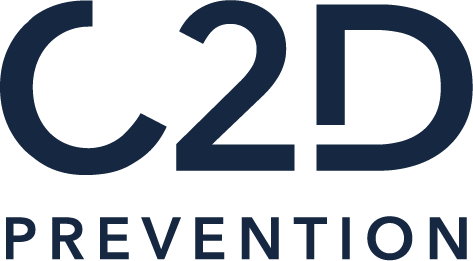Home > Who Are We?
About C2D Prévention

C2D PRÉVENTION
Who Are We?
A consultancy firm specialising in the implementation of strategies, support, and tools designed to ensure control over the physical and mental safety of all company members, with the aim of preventing workplace accidents and promoting the development of Quality of Life and Working Conditions (QLWC).
Our Team
Our team is made up of experienced specialists in risk analysis, the DUERP (Single Risk Assessment Document), project management, coaching and support, as well as experts in neuroscience, legal knowledge applied to risk prevention, and organisational psychology.
Our professionals combine diverse skills, some of them having dual training: from management to law and applied neuroscience, or from psychology to philosophy. The interdisciplinary nature of our team brings a social, ethical and practical dimension to our interventions, exerting a real impact on both the employee and the organisation.
The C2D Approach
Being supported by C2D Prevention means instilling a Health and Safety at Work culture based on the proven “CAP” method.
A structured approach rooted in legal, psychological and neurocognitive foundations for the implementation of lasting and effective actions to prevent risks across the three levers of health and safety culture: Human, Organisational and Technical.
Nous intervenons sur les 3 leviers de la Culture sécurité et santé au travail :
Human.
Organisational
Technical
We work with companies of all sizes and across all sectors.
Our objective:
to establish and ensure the Continuous Infusion of a well-managed culture of physical and mental health and safety, and Quality of Life and Working Conditions (QLWC).
Our Expertise
C2D approach
At C2D, we listen to your needs and offer a unique approach based on five key pillars:
1C2D Prevention Methodology: CAP
A. STRUCTURE
Our model is based on the “CAP” method:
C for
Comprehend
A for
Architect
P for
Produce the Infusion
All with the aim of Staying on Course (CAP) for Continuous Infusion.
B. Change Management
Improving and reinforcing the safety culture does not happen in a few weeks. It requires carefully managed change.
This is based on three essential levers (following the Prosci method):
Sponsorship and support from senior management to implement actions and provide the necessary resources
Project management based on the three pillars of the safety culture: Human, Organisational, Technical
Consideration of the Human Factor in managing change. To manage inevitable resistance, change adoption involves the following steps:
- Explaining why change is important
- Giving meaning to the change to create personal motivation
- Training change actors in the knowledge, skills and behaviours expected
- Lastly, successful and lasting change depends on effective follow-up and adjustment methods for the desired attitudes and actions
C.Ensuring the autonomous and Continuous Infusion of a robust safety culture: the KBInfusers
Mastering a culture of Prevention/Health & Safety
relies on deploying appropriate actions and behaviours, combined with an organisation that enables their development.
To achieve these goals, it is essential to identify the expected behavioural indicators and to ensure their monitoring, measurement and evolution.
The practical implementation of KBInfusers provides an effective and structural response to these needs.
KBInfusers sustain the defined HSW (Health & Safety at Work) architecture.
In other words: Stay on Course (CAP) towards the defined objectives for effective and efficient management of a well-established health and safety culture.
2Complementary Expertise
We incorporate perspectives that take into account the various dimensions of the company: the individual, the collective, and the organisation as a whole, in order to propose strategic and sustainable solutions aligned with your company’s goals for operational excellence.
L'individu
Le collectif
L'organisation
This interdisciplinarity – combining legal, neuroscientific, psychological and managerial skills – allows us to respond effectively to the multifaceted challenges faced by organisations.
3Expertise in Legal and Neuroscientific Knowledge
C2D possesses in-depth knowledge of neuroscience and legal comprehension related to physical and mental safety at work, offering a comprehensive approach to its interventions.
Aware that every company and its ecosystem evolves, we offer flexible, robust solutions based on a method and tangible results. Our interventions are thus designed to adapt to the organisation’s transformations and needs, guaranteeing lasting and tailored support.
4Tailored Learning
We promote experiential learning, as change occurs through engagement and action. This approach, known as andragogy, is centred on the adult learner, considering their experience, autonomy, and specific needs. Unlike pedagogy, it relies on active involvement, problem-solving, and practical application of knowledge.
The learner is seen as a partner in the educational process. Personal, professional and social motivations play a key role in their commitment. Andragogy encourages self-directed, interactive and contextualised learning.
This learning approach allows for dynamic exploration of behaviours and attitudes, fostering real ownership of the new knowledge and skills expected.
5Specialisation in QLWC
Quality of Life and Working Conditions (QLWC) plays a central role in employee well-being and company performance. More than just a regulatory obligation, it is a strategic lever to promote, among other things: engagement, motivation, and risk prevention.
As ANACT (the French National Agency for the Improvement of Working Conditions) reminds us, sick leave due to psychological causes costs twice as much as that due to physical causes, highlighting the urgency of rethinking workplace well-being.
Investing in QLWC means building an environment where individuals can thrive while contributing to the sustainable success of the organisation.
